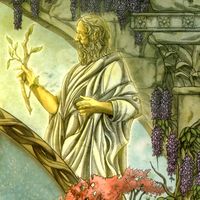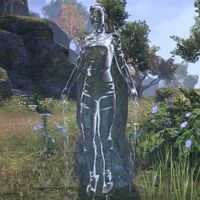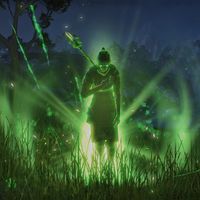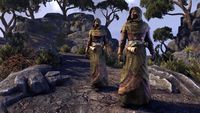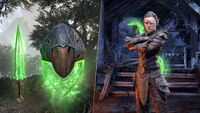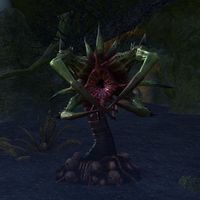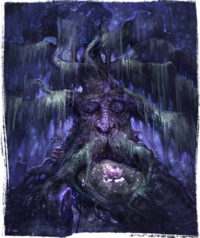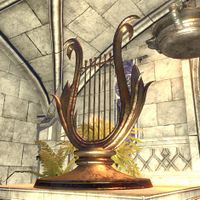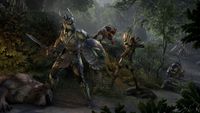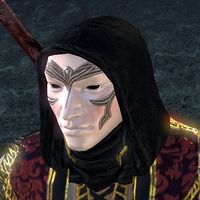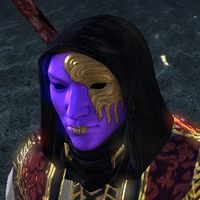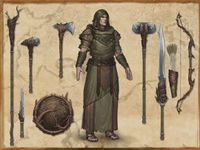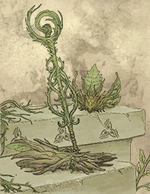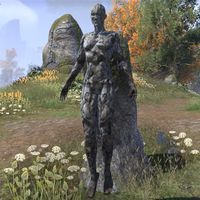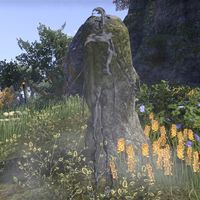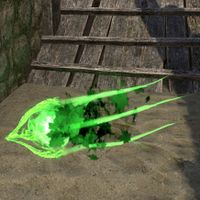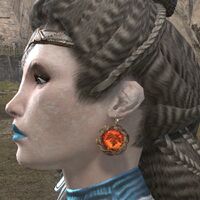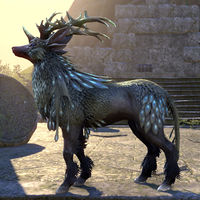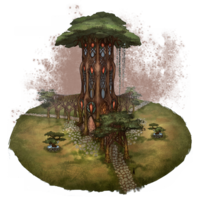Lore:Y'ffre
Y'ffre (also spelled Y'frre, or known as Jephre or Y'ffer),[1] the Singer, the Storyteller, the God of Song and Forest, and the Spirit of the Now, is the most important deity of the Bosmeri pantheon, also worshipped by the Altmer, Bretons, and Snow Elves.[2][3] He (occasionally she)[4][5][6][7] was one of the strongest of the recognizable spirits that crystallized shortly after the beginning of time, and played an important role in the coalescing of the physical world during the Dawn Era.[8]
He is said to have been the first of the Ehlnofey to transform himself into an Earth Bone, a law of nature,[UOL 1] giving rise to the rules and principles of nature and life on Nirn.[9][10] Y'ffre's "Earthbones" are said to have been created from his corporeal form to establish safety and the laws of nature. These laws took the shape of stories, and there is great debate between Bosmer tribes competing to interpret Y'ffre's ways and knowledge of the times of chaos, before Y'ffre arrived on the mortal plane.[11] He thus formed the frame upon which nature is woven, said to have gained sight-perception of all that occurs within the sight of birds and the reflection of waters through his song, and to echo their songs and crashing waves. While seeing and hearing nothing himself, his sight-perception and song are loomed through the laws he established, for mortals to interpret through study of the Sea's mystery. Day, night, and the places between are the manifestation of his interpretation of the time-law Anui-El is said to have established within Nirn.[12]
Y'ffre is known to sometimes intervene to select figures such as the Silvenar, even resurrecting the Silvenar to be from death should the need arise.[13], as well as to send wisps to herald the storms of Rain's Hand. To see one such wisp is to be to see the promise of new growth, new life, and a new chapter in nature's cycle.[14]
The Storyteller[edit]
Y'ffre is strongly associated with songs and stories, as a mythical expression of his role in shaping the story of nature. His acts of creation are described as "tales",[4] and he is said to have given the first name to every living creature, solidifying their place in the world.[15] Y'ffre sang to Aetherius, weaving songs so beautiful that the stars were compelled to dance and sway, continuing to wink and blink afterward in memory of that song as the realms of Aetherius which those stars are windows to likewise dance and sway to Y'ffre's music.[12] Y'ffre's priests, called Spinners, also experience life as one long story, as they not only keep the histories and laws of their people, but also narrate events that have yet to occur.[16] As Y'ffre instructed the world and the first Bosmer through tales, so too do the Spinners elucidate and educate their kin through elaborate, sometimes befuddling, metaphors, that nonetheless always contain an essential truth.[17] Spinners can use their "narrative magic" to profoundly alter the stories of others, even altering their memories of past events.[18]
Bosmer priests known as Namespinners can perceive another person's protonymic, unweave it slightly and then chant a new suffix into it in order to alter the physical form of a person. This ability can be used to give antlers to Bosmer who are deemed worthy of this decoration.[19]
Y'ffre and Nature Spirits[edit]
We were the Y'ffre. Then we became the Ehlnofey, the Earth Bones. … " —Guardian of the Earth
Nature Spirits are described as "dreams of the Green" and "forces of nature in the bosom of Y'ffre",[20] made real and given form and purpose either naturally or through the will of practicioners of Nature Magic such as the Druids and the Wyrd.[21][22] Certain greater spirits are said to be a subset of Y'ffre's laws shaped into spirits through Nature Magic, or to have been bound to a location with a certain task by Y'ffre himself.[23][24] They are said to reside in all things, rocks, roots, leaves, brooks, the wind, a field of flowers, or even a swarm of Torchbugs, though their will might be difficult to perceive, even for those who know how to listen.[25] According to the Augur of the Obscure, waterfalls house a deluge of water spirits, and each individual stone has its own spirit with its own stories to tell.[26]
Nature spirits that haven't yet emerged into the physical world are said to "slumber" within the Green, druids use a concoction named the "Elixir of Y'ffre's Thoughts", said to temporarily turn the imbiber into a dream or memory also, to communicate with them and exchange knowledge while in that state.[21] When a nature spirit "dies", it returns to its slumber within the Green, ending its current incarnation,[27][23] though vanquished nature spirits are said to reform or reincarnate, eventually.[20][28]
The Beldama Wyrd are a witch coven attuned to nature. They venerate the Breton interpretation of Y'ffre, Jephre.[29] They are guided by elemental spirits known as the Guardians,[30] which are among the extinct Ehlnofey who claim they were once Y'ffre.[31] The Guardians are said to have been present since the dawn of Tamriel[30], nurturing and protecting the land and serving as guides to the Wyrd. They are linked to the Wyrd Tree, a nature spirit older than Men and Mer that takes the form of a gargantuan oak tree that emits an unnatural glow, it gives life to the land and strength to the Wyrd, and conceals secrets from when time began, its roots stretching all across Nirn and touching everything, even the "bones of the world".[32][33][29][34][35][36] The Guardians aided the Vestige in cleansing the corruption of Angof the Gravesinger from the Wyrd Tree, using their power to provide protection from the power of the elemental wraiths called forth by Angof, whose magic would have otherwise been fatal. They repudiated Angof and his Bloodthorn Cult for their pacts with the Daedra, claiming that their deeds "mocked the Aedra, the Ehlnofey" and polluted the land with dark magic.[31][37][38][39]
Worship[edit]
Bosmer[edit]
The Bosmer believe that, during the chaos of the Dawn Era which they call the Ooze, there was a state of existence where all life and land on Nirn were formless and shifted constantly between shapes, unable to hold one form for more than a moment, acknowldged also in Altmer myth. It was Y'ffre who granted all things their Names and gave them an enduring form. The Bosmer thus believe that after they made the Green Pact with Y'ffre, he taught them how to escape that chaos and retain their form, but also how to return to it by instigating the Wild Hunt Returning to the chaotic shifting of Ooze can also be done without the need of collective ritual, though that act is deemed a breach of the Green Pact and punished as such.[40] As all life started as part of the shifting chaos of Ooze and had their shapes taught to them by Y'ffre, getting caught up in the vicinity of a Wild Hunt ritual can thus also lead to non-Bosmer forgetting their taught shapes, the bonds of the Name bestowed upon them unraveled, and transform into Wild Hunt creatures.[10][4][41][42][43]
Some sources claim that the origins of the Wild Hunt might lie with the emergent elves' observation of the Ehlnofey during primordial times. It is said that, while the Dwemer would learn how to defy the Earthbones by observing the Ehlnofey controlling the natural laws governing things such as decay and the passage between realms, the Aldmer clans from which the Bosmer would eventually emerge would witness the passing of Y'ffre, who was the first of the Ehlnofey to give of themselves to Mundus fully and become an Earthbone, learning how to defy the Earthbone he established to govern the physical form of things through observing him. It is said that this is the knowledge modern Bosmer invoke to enact a Wild Hunt, reverting to what life truly is beneath Y'ffre's imposed law. The reason for the seemingly undying nature of such Hunt creatures is said to be that in severing themselves from the control of one Earthbone, others also lose their power to impose their own laws on them, thus leading to the Earthbone governing lifespan also losing its power.[UOL 1]
The Bosmer believe that out of the primordial Ooze, Y'ffre first brought forth the Green, consisting of all plant life and the natural world of Nirn, from mosses to the mighty graht-oaks, teaching the birds to sing and the waves to lap against the beach and gaining sight-perception of all that occurs within the sight of birds and the reflection of waters.[4][12] Next to materialize were Y'ffre's people, the Bosmer. He instituted the Green Pact between the Bosmer and the Green, which forbade any harm to the plant life of Valenwood. In exchange, the elves could request the forest shape itself to their needs, providing food and shelter, and also were able to tap into certain atavistic forces of nature, reflecting their chaotic origins.[44] It is said that even after Y'ffre created the Green and shaped life, some formless nothing still remained. Y'ffre decided to speak one final story to give the Ooze purpose, saying that any being who violated the Green Pact with the Valenwood would be cast into the Ooze and stricken from the story of Tamriel.[4] Bosmeri legend holds that any who break the terms of the Pact will be consigned back into the Ooze, their song in the world replaced with silence.[4] In modern times, the Pact is enforced by regional "treethanes", who are responsible for a certain jurisdiction and dedicated to the preservation of the natural resources therein.[45]
The Changelings are shapeshifting nature spirits[46] that were once prevalent in Valenwood. When Y'ffre introduced the Green Pact many of them gave up their formlessness to become Bosmer, with those who refused it becoming known as Oathbreakers and being hunted down to be interred in the tarpits of Ouze, believed to serve as a conduit leading to the primordial formlessness of Ooze, where Y'ffre decreed Oathbreakers would be interred. These spirits view Y'ffre's imposition of name and shape and of the Green Pact as a form of imprisonment, which they refused as they had no wish to give up their shapeshifting abilities.[47][48]
The Eldest, an ancient Strangler said to be the very life of Greenshade and tied in myth to the origin of the first Silvenar and Green Lady who are believed to have originated as a couple of Y'ffre's pilgrims who watched over the sacred plant,[49][50] and Brackenleaf, a sapient speaking tree, are believed to be among the first creations of Y'ffre in the Green. The heart of Brackenleaf is believed to contain the power of Y'ffre, the same power used to create the world, and for that reason it has been sought by those who wish to take that power for themselves since the beginning of time.[51][52]
The Ring of the Wild Hunt is a Bosmeri artifact associated with Y'ffre, curiously the relic depicts the god Y'ffre in an uncommon manner, as a ferocious figure that's howling or snarling behind a matted wreath of leaves. It is believed this might be a depiction of Y'ffre unleashing the power of the Wild Hunt [53][54]
It is said that as the forces of nature take root, so too do the blessings of Y'ffre. The Bosmer are known to wield Y'ffre-Bound weapons in which Y'ffre's blessings have taken root, visibly graced by the God of Song and Forest and glowing green with the essence of nature.[55]
Altmer[edit]
Like the Bosmer, Altmer also acknowledge that prior to Y'ffre granting things names, all life was formless and constantly shifted shapes, and consider the deity's establishment of defined form as something to be grateful for.[41] Their prayers often emphasize their believed ancestral connection with the Aedra, urging the faithful to give praise to the Divines and thus to their own ancestral lines, and describing the Altmer as always having the gods in their lives. It is said that the body of the divine wills the Altmer into being, and that they are one with the gods, their ancestors, and so should venerate them as one. Such prayers give praise to Y'ffre as God of the Forest and first of the Ehlnofey, the Earthbones, who showed the way.[56][57]
Indriks are magical creatures that bear some relation to Jephre and are said to have been woven by Y'ffre out of the essence of the forest. They are incarnate nature spirits, [58] theorized to be divine beings, closer to Aedra than to mortals.[59] They seem to draw strength from the bones of the earth beneath their hooves.[60] They can be found within the forests of Summerset Isle, though they are very elusive. It is said that Indriks never truly die, their souls don't leave Mundus but are instead taken by Jephre, who plants them back into Nirn to sprout again as fawns.[28]The equipment of Jephrine Paladins is modeled after Indriks. All that is known of Jephrine Paladins is that they are protectors of the wilds.[61] Unlike the Bosmer, Altmer demand obedience and perfection from the nature, shaping it to fit their needs to improve it to make it more artistically perfect forcefully - be it through magical or mundane means, despite their appreciation for nature.[62][63]
Some of the masks worn by members of the House of Reveries during their performances are associated with Y'ffre and used to symbolize aspects of his mythology. The Flowervine Mask is chosen to represent growth, nature, or aspects of Y'ffre,[64] while the Breath of Y'ffre Mask invokes the mystical moment when the entities of creation were named and shaped by Y'ffre, as order intertwined with chaos to bring forth the Green.[65]
Breton[edit]
To the Bretons, Jephre (also known as Jeh Free)[66] is the God of the Forest and the spirit of the "now". Bretondom originated from Nedes and Aldmer interbreeding, and so their understanding of the god was greatly influenced by Direnni culture.[67] He is typically considered more of an elven god, and is understood to have turned himself into the Earth Bones and establishing the laws of nature.[10]
He is still revered by some Breton hunters and farmers.[33] Bretons respect the Vicars of Jephre, a group of his adherents who are known defenders of the natural world.[68] When the First Empire took control of High Rock, they forced the Bretons to convert to the worship of the Eight Divines, however, the worship of lesser deities still persisted and Jephre continued to be worshiped.[33]
Of the Breton subcultures, Y'ffre and the Earthbones play a central role in the beliefs of both the Druids and the Wyrds.[69]
Druids[edit]
The Druids are said to commune with the voices of Y'ffre and the Earthbones for guidance and tap into their power through their magic.[24] [70]. They also refer to Y'ffre by the following titles; the Green-King, the Slumbering Father of Nirn,[69] or the Green Man.[71] Their Nedic ancestors[72] were known as the Druids of Galen,[73] who adhered to the True Way in which one is to lead a life connecting with and valuing the natural world.[24]
Some sources claim that Druidic culture first emerged on an island named Galen, in the middle of a lake where Y'ffre's beating heart could be heard. Other tales claim the culture was established by a person named Galen, who was either the first Druid Queen who first heard Y'ffre's song, or a great spirit of nature who wandered into settlements and taught of Y'ffre and the Green.[74] Though their Breton's forebears knew of Y'ffre, the name "Y'ffre" itself is said to have only become known when the "sons and daughters of Anuiel" taught it to them.[69]
When the Druids departed for the Systres, it is said they did so following visions which Y'ffre had sent to Druid King Kasorayn.[75] Naturally, Y'ffre took the forefront of their faith. These Nedes survived in ancient High Rock by tapping into, nurturing, and terraforming nature.[69] When the Druids of Galen experienced the "three mornings of sail" sometime after settling on the Systres, three sects developed, each with their own interpretation of Y'ffre's will; the Stonelore, Eldertide, and Firesong Circles. Druids of the Firesong Circle claim they can still hear Y'ffre's voice in the restlessness of Mount Firesong.[76][77]
Some druidic myths refer to Y'ffre as female, one such myth claims that upon the felling of a maple grove Y'ffre wept and her tears, lamentation given form, fell upon the leaves. She then instructed the druids to take these amber teardrops and wear them from that point on in memory of that day.[6]
Wyrds[edit]
The Wyresses believe that during Y'ffre's Naming, the act which gave all life on Nirn its shape,[43] the deity tasked the Earthbones to choose those who would become the guardians of nature,[15] a task ultimately given to the Wyresses, the Name-Daughters, who are descendants of the Ehlnofey themselves.[29] The Beldama Wyrd are a witch coven attuned to nature, and are also known to venerate the ancient forest and commune with Jephre the Storyteller.[29] They are guided by elemental spirits known as the Guardians,[30] which are among the extinct Ehlnofey who claim they were once Y'ffre.[31]
Khajiit[edit]
Y'ffer is the equivalent of Y'ffre in the Khajiiti pantheon, but despite his appearance in Khajiiti myth, he is not considered a figure of worship. Prior to the Riddle'Thar Epiphany, he was recognized as a bastard son of Ahnurr, though his temperament was said to be the opposite of his father's. Of the known stories involving Y'ffer, he is often linked with Nirni.[1]
In older traditions, Y'ffer became Nirni's mate after creating the first flower for her and fathered many of her children.[1] Hircine was considered a rival for Nirni's affections, so in response to this, Hircine slew Y'ffer's champion, the Graht-Elk and wore its head as a trophy.[1] With more recent stories, such as those attributed to Clan Mother Ahnissi the relationship between Y'ffer and Nirni is downplayed. Y'ffer is portrayed as a nosey spirit that can't keep secrets, with him eavesdropping on Azurah's creation of the Khajiit. He promptly told Nirni the secret he overheard, and in gratitude she allowed him to alter some of her children in the same manner, resulting in the first Bosmer.[78]
These same stories also hold Y'ffer responsible for "Fadomai's Children" (i.e. Daedric Princes) being able to cross the Lattice and enter Nirn, as he loudly shouted the secret.[78] Some older stories claim that sometime after the death of Lorkhaj, Y'ffer also became corrupted by the Great Darkness and killed Nirni. In response, he was destroyed by the combined efforts of Azurah, Khenarthi, and Hircine. Afterwards they used his bones to create a cairn for their beloved sister. Due to these events, though the "woodland folk", the Bosmer, claim they can still hear Y'ffer's voice, the Khajiit no longer speak of him.[1]
Argonian[edit]
The creation myth of the Adzi-Kostleel tribe makes mention of a forest spirit which can be considered a representation of Y'ffre. The tale describes how, in the chaos that engulfed the cosmos in the wake of Atakota's awakening, the spirit came and saw that the Roots loved their children like she loved hers. So she taught the Roots how to walk and talk, and in exchanged the roots taught her secrets which she sang back to them. When the roots heard this song they woke up, and joined with the forest.[7]
An Argonian heresy relating to Y'ffre emerged among the refugees who fled to Valenwood from Black Marsh after the creation of the Ebonheart Pact. Having severed their ties to the Hist, many of these Argonians turned to Y'ffre and the trees of Valenwood in the hope that he could allow them to reproduce. This heresy was potentially ended in 2E 582 when ex-Shadowscale refugees assassinated those responsible for abandoning the Hist.[79]
One Argonian Druid affiliated with the Stonelore Circle came to believe that Y'ffre was a shepherd of the will of Sithis, as change itself adheres to physical laws, such as a tree falling down and not up.[80] Whatever the case, principles of change, decay, and the cyclical nature of life are considered a natural aspect of Y'ffre's laws, represented by a great dual-faceted nature spirit called the Evergrowth and Allwither.[24]
Other[edit]
The Imperials were strictly prohibited from worshiping Y'ffre due to the Alessian Empire's religious laws. Its unknown if the ban remained in place after the fall of the Alessian Empire.[33]
The Dark Elves believe in Jephre to some capacity, as he appears in their mythos. According to legend, Jephre walked the land on the first day and swayed the stars with a beautiful symphony. Some of the stars wink and blink to this very day, in homage to the song of night and darkness.[3]
Although Ayleids followed the Daedra, the Aedra of Elven pantheon were still widely revered, with probably a majority of the Ayleids continuing to pay them homage, but cults devoted to the various Daedric Princes sprang up across Cyrodiil, tolerated and then celebrated.[81] Eventually the Aedra worshipping Ayleids were driven out of Cyrodiil, with some taking refuge in western Black Marsh. According to an ancient Ayleid myth Y'ffre, the "Elden King of Graht", is said to have eventually been corrupted by the Great Darkness, having "drank of the dark and became something more".[82]
Artifacts[edit]
Druid King's Regalia[edit]
The Druid King's Regalia consists of a crown, a gauntlet, and a staff which were created by the god Y'ffre. These gifts were worn with wisdom and mercy by the line of Druid Kings,[83] and serve to legitimize one's ascension to the Ivy Throne.[84] After the death of Kasorayn, the last Druid King, they remained dormant within sacred seeds entrusted to the three main Druidic Circles.[85] The regalia supposedly has no innate power of their own,[76] but after a pretender stole the Druid King's Regalia, they almost brought upon the Green Scourge which would have called forth the wrath of nature upon Tamriel but they were slain before being able to do so.[20]
The Regalia serves to crown one as Druid King, said to be the only one who can safely invoke and command even the greater spirits of nature.[23][20]. A wielder of the Regalia can also command a nature spirit to merge with them in order to gain its power. [86] The Regalia can also be used to allow a nature spirit to bind itself to an area and take on a new role, replacing that region's prior spirit, such an event occurred when the spirit Frii became the new spirit of Mount Firesong in order to prevent the volcano from erupting and destroying the Systres archipelago.[21][20]
The Psijic Order had the means to scry secrets from fate lines beyond the bounds of Tamriel. Among these secrets were tomes that spoke of alternative timelines and realities, where certain key events transpired differently.[87] In one of these alternate realities, the pretender succeeded in defeating his enemies and conquering Tamriel and the Green Scourge came to pass. Tamriel was engulfed in firestorms targeting "false kings and queens" and displacing populations and the days became dark, cold and filled with turmoil as volcanoes continued to "belch forth their retribution" covering the skies.[88]
Ring of the Wild Hunt[edit]
The Ring of the Wild Hunt is an ancient ring which plagues the wearer's dreams with frightful images of hunters and prey. In exchange, it blesses the wearer with Y'ffre's swiftness, increasing the speed of whomever possesses it.[53][54]
The ring is composed of five different pieces:
- The Band of Water: A small band which possibly depicts a liquified Bosmer.
- Charm of the Shapeless: A bizarrely shaped green charm and a possible relic of the Wild Hunt.
- Face of the Serpent: Possible imagery of the Wild Hunt, resembling a serpentine beast.
- Face of the Wolf Beast: A monstrous animal resembling various different creatures, possibly a depiction of King Dead Wolf-Deer.
- Symbol of Y'ffre: A depiction of Y'ffre as a ferocious figure snarling behind a matted wreath of leaves, thought to be a depiction of the God unleashing the power of the Wild Hunt.[54]
Gallery[edit]
Notes[edit]
- Early design documents for Daggerfall named Jeh Free as the god of languages with followers such as The Society of Jeh and The Encyclics,[89] before changing his name to Jephre in the final version.[90] The name Jeh Free still appeared in the final game when mentioned in King Edward, where Moraelyn is described as being so skilled in music that Jeh Free and Jhim Sei could have taught him.[66]
References[edit]
- ^ a b c d e The Worldly Spirits — Amun-dro, the Silent Priest
- ^ Knight-Paladin Gelebor's dialogue in Skyrim
- ^ a b Of Jephre — Anonymous
- ^ a b c d e f The Ooze: A Fable
- ^ The Elder Scrolls: The Official Survival Guide to Tamriel — Tori Schafer
- ^ a b Amberleaf Earring description in ESO
- ^ a b Children of the Root — Solis Aduro
- ^ The Monomyth
- ^ Dringoth's dialogue in ESO
- ^ a b c Varieties of Faith... — Brother Mikhael Karkuxor of the Imperial College
- ^ The Improved Emperor's Guide to Tamriel: Valenwood — Flaccus Terentius, 2E 581
- ^ a b c Girnalin's dialogue in ESO
- ^ Striking at the Heart quest in ESO
- ^ Galen Wisp collectible description in ESO
- ^ a b Wyresses: The Name-Daughters — Glargargil the Speaking Oak
- ^ Spinning a Story — Cirantille
- ^ The Spinners of Y'ffre — Cirantille
- ^ Gwaering Answers Your Questions — Gwaering
- ^ Loremaster's Episode of ESO-RP ZOS Interview
- ^ a b c d e Druid Laurel's dialogue in ESO
- ^ a b c Frii"s dialogue in ESO
- ^ Cinderstone Kagouti mount description in ESO
- ^ a b c Elder Pitof's dialogue in ESO
- ^ a b c d Druid Audrine's dialogue in ESO
- ^ Druid Ryvana's dialogue in ESO
- ^ Augur of the Obscure's dialogue in ESO
- ^ The Chronicle's dialogue in ESO
- ^ a b Talomar's dialogue in ESO: Summerset
- ^ a b c d Witch Cults of Northern High Rock — Wafimeles Masteret (Lorekeeper)
- ^ a b c Wyress Ileana's dialogue in ESO
- ^ a b c Guardian of the Earth's dialogue in ESO
- ^ Wyress Helene's dialogue in ESO
- ^ a b c d The Improved Emperor's Guide to Tamriel: High Rock — Flaccus Terentius, 2E 581
- ^ Wyress Jehanne's dialogue in ESO
- ^ Wyrd Tree verse
- ^ Crafting Motif 93: Ancestral Breton Style — Serge Serlyn, "Military Scholar of Much Renown"
- ^ Guardian of the Water's dialogue in ESO
- ^ Guardian of the Air's dialogue in ESO
- ^ Corruption of the Tree's encounter in ESO
- ^ Pocket Guide to the Empire, 1st Edition: Aldmeri Dominion — Imperial Geographical Society, 2E 864
- ^ a b Brief Letter to an Aldarch in ESO
- ^ Wild Hunt Horse mount description in ESO
- ^ a b Wild Hunt Crown Crate season description in ESO
- ^ The Green Pact and the Dominion
- ^ Wood Elf Etiquette: An Imperial Perspective — Kerandas Calvus, in the year 2723
- ^ Selene's dialogue in ESO
- ^ Oathbreakers of Ouze
- ^ The Voice of Ouze's dialogue in Back to Rest
- ^ Indaenir's dialogue during The Blight of the Bosmer in ESO
- ^ The Eldest: A Pilgrim's Tale
- ^ Eringor's dialogue in ESO
- ^ Glaras' dialogue in ESO
- ^ a b Ring of the Wild Hunt's description and bonus in ESO
- ^ a b c Ring of the Wild Hunt's codex entries in ESO
- ^ Y'ffre-Bound Style description in ESO
- ^ Praise Be
- ^ Mirnor of Auri-El's dialogue in ESO
- ^ Nascent Indrik mount description and appearance in ESO
- ^ Y'frre's Sparkling Steeds — Melobrian
- ^ Dawnwood Indrik mount description in ESO
- ^ Eat Cake & Earn Bonus Rewards During The ESO Anniversary Jubilee showcasing Jephrine Paladin Style on the official ESO website
- ^ Saltspray Cave's loading screen in ESO
- ^ Riliadir, viewing gardens in Auridon — Riliadir
- ^ Reveries Flowervine Mask hat description in ESO
- ^ Breath of Y'ffre Mask hat description in ESO
- ^ a b King Edward, Part 2 — Anonymous
- ^ Pocket Guide to the Empire, 3rd Edition: All the Eras of Man, A Comprehensive History of our History — Imperial Geographical Society, 3E 432
- ^ Priest of the Green costume description in ESO
- ^ a b c d Wyrd and Druid — Archdruid Barnabe's Discourse with Mainlanders, 2E 553
- ^ Legacy of the Bretons — Stefan Mornard
- ^ Druidic Kettle Spout antiquity codex entry in ESO: High Isle
- ^ Count Damard Dufort's dialogue in ESO
- ^ Race Description of Breton in TES:Arena
- ^ Loremaster's Archive - The Druid Circles of Galen — Laurel of the Stonelore
- ^ Exodus of the Druids — Druid Laurel of the Stonelore Circle
- ^ a b Druid Ryvana's dialogue in ESO
- ^ Systres History: Volume 1 — Trilam Heladren, Associate Dean of Eltheric History, University of Gwylim
- ^ a b Words of Clan Mother Ahnissi — Clan Mother Ahnissi
- ^ Scars Never Fade quest in ESO
- ^ Druid Peeska's dialogue in ESO
- ^ Daedra Worship: The Ayleids — Phrastus of Elinhir
- ^ The Nine Coruscations — Star-Queen Varalias
- ^ Elder Verline's dialogue in ESO: Firesong
- ^ Archdruid Orlaith's dialogue in ESO: Firesong
- ^ Druid King Kasorayn's dialogue in ESO: Firesong
- ^ The Ivy Throne quest in ESO
- ^ Tracker of Temporal Tomes achievement description in ESO
- ^ Coral Aerie Temporal Tome — Varallion
- ^ Files from Daggerfall Preview
- ^ Shrine locations in Daggerfall
Note: The following references are considered to be unofficial sources. They are included to round off this article and may not be authoritative or conclusive.
| |||||||||||||||||||||||||||||||
| ||||||||||||||
| ||||||||||||||||
| |||||||||||
| ||||||||||||||||||||||||||
| |||||||||||||||||||||||
| ||||||||||||||||||||||||||||||||||||||||
| |||||||||||
